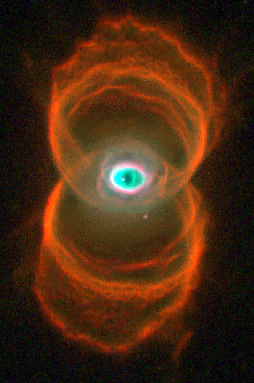Astronomy Picture of the Day
Discover the cosmos! Each day we feature a different image or photograph
of our fascinating universe, along with a brief explanation written by a
professional astronomer.
January 18, 1996

MyCn18: An Hourglass Nebula
Credit:
R. Sahai and J. Trauger (JPL),
WFPC2 Science Team,
NASA,
Explanation:
The sands of time are running out for the central star
of this hourglass-shaped
planetary nebula.
With its nuclear fuel
exhausted, this brief, spectacular, closing phase of a
Sun-like
star's life
occurs as its outer layers are ejected - its core becoming a cooling, fading
White Dwarf.
Astronomers have recently used the
Hubble Space Telescope (HST)
to make a series of
images of planetary nebulae, including
the one above.
Here, delicate rings of colorful glowing gas
(nitrogen-red, hydrogen-green, and oxygen-blue)
outline the tenuous walls of the "hourglass".
The unprecedented sharpness of the HST images has
revealed
surprising details
of the nebula ejection process
and may help resolve the outstanding mystery
of the variety of complex
shapes and symmetries of planetary nebulae.
Tomorrow's picture: The Dusty Disk of Beta Pic
| Archive
| Index
| Glossary
| Education
| About APOD |



Authors & editors:
Robert Nemiroff
(GMU) &
Jerry
Bonnell (USRA).
NASA Technical Rep.:
Sherri
Calvo.
Specific rights apply.
A service of:
LHEA
at
NASA/
GSFC



